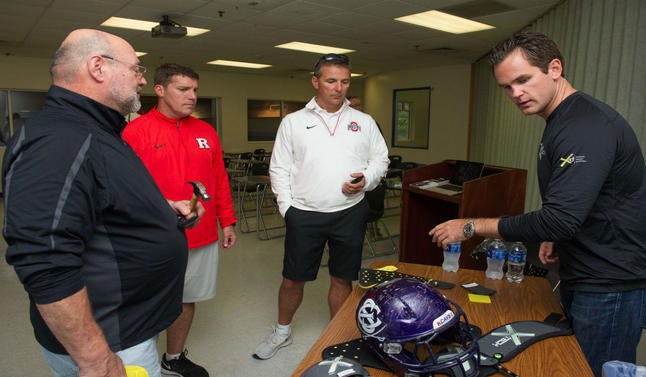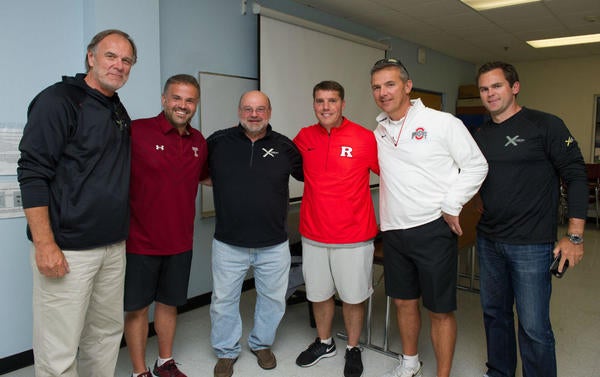Urban Meyer's reaction was priceless.
The Ohio State head coach's face was a mix of panic and confusion as he leapt away from the desk where a man he had just met was brandishing a helmet in his left hand. The man was Bob Broderick, a former New York Giants ballboy and longtime marketing consultant who is the founder of innovative shoulder pad and protective equipment company XTECH, and he had just hoisted the helmet above his head to make a point.
Broderick's right hand was already tucked between two thin pieces of patent-protected, scientifically-designed foam and in an instant the entrepreneur was slamming the helmet, quite violently, across the desk into the padding, scattering bottled waters and other items to the floor. Broderick quickly pulled his right hand up off the desk – clearly no worse for wear – and extended it to Meyer, who shook it somewhat sheepishly, still trying to grasp how Broderick had escaped without so much as a bruise or scrape. Turns out the combination of that foam, known as XRD Technology – the brainchild of an MIT-trained chemical engineer – and the design concepts Broderick and his partner Ted Monica, a former equipment manager in the NFL and USFL who once oversaw shoulder pad design at Riddell, had created was a perfect marriage. And Meyer had just become the latest XTECH convert, joining a legion of players, coaches and NFL, college and high school programs.

Player health and safety is a constant buzzword across the football world, but it's generally couched in terms of helmets and head and neck injuries. Just this week the NFL and NFLPA announced 10 models of helmets they were banishing – including the headgear of choice for Tom Brady, perhaps the greatest player in the history of the sport – and sensitivities are heightened following a 2017 season in which a succession of star quarterbacks were felled by what amounted to season-ending injuries, whether it be Aaron Rodgers, Andrew Luck, Deshaun Watson, Carson Wentz, Carson Palmer or Sam Bradford. Shoulders – those of $20M-a-year quarterbacks in particular – have never been more vital to the fabric and finances of the game, yet shoulder pads have long been something of an afterthought, with many players unsure of which model they wear and long-accustomed to simply throwing on whatever the equipment guy hands them at the start of the season.
Changing attitudes
Perhaps that is slowly, finally changing, as Broderick, Monica and their growing stable of investors, including former Super Bowl-winning coach Brian Billick, are convinced that this technology has the capacity to make the game much safer. They believe that Rodgers, had he been in their model, would not have suffered as severe a collarbone break last season, and they are eager to get an audience with him, while Luck, who has essentially missed two seasons due to shoulder issues, is scheduled to meet with Monica in two weeks and has long been considering switching to XTECH for his comeback.
Meyer, for his part, after speaking with Broderick and Monica for a few more minutes about their technology, promptly called his equipment manager and medical staff right there on the spot (Rutgers coach Chris Ash and then-Temple and now Baylor coach Matt Rhule were also in the small office at the time, their teams already in XTECH). Two weeks later, XTECH was on campus in Columbus, Ohio, meeting with Meyer and sizing players. Soon, roughly 80 percent of the Buckeyes would be in the pads. Josh Allen and Josh Rosen, two of the top quarterbacks in this year's draft, are big believers in the product. Players on 29 of 32 NFL teams now wear them, as well, as do more than 250 colleges and over 200 high schools (including Trevor Lawrence, the top-ranked 2018 prep quarterback who is headed to Clemson, and Taron Vincent, a five-star recruit headed to Ohio State whose father, Troy, just happens to be a former All-Pro defensive back who is the head of the NFL's football operations department).
"You can go through the matrix and talk about all of the technology and the science and the testing numbers," said Billick, who was in the room as well when Meyer was initially spooked. "But when you see that demonstration with the helmet – and that's real, that's not some stunt – that shows you the quality of these pads. And I'll challenge any other equipment company to come in with their hands, and we'll do it with our pads and you can try it with yours.
"I've known Bob for years and when he brought the product to me it was in the development stage and he was deciding whether he was going to take this on or not, and he said, 'What do you think?' And I say this all of the time, with the concussion protocols and rule changes we are taking the head and helmet out of the game, but that means even more stress on the shoulders and those injuries. And with this XRD Technology and XTECH patented design, basically these are custom-fitted, lightweight pads that allow for greater range of motion and protection.
"This is where pads need to be and obviously they are evolving in other sports as well, and when I saw this product I said, 'I'm all in.' You ask players what gloves they wear and what shoes they wear and they can tell you exactly what in any conditions or cold weather or whatever. And then you ask them which shoulder pads they wear, and you get a blank stare. The shoulder pads really hadn't changed in 25 years, but they are now, and they need to."

Shoulder pads are the long-forgotten element in this safety rubric, even at a time when shoulder injuries to quarterbacks can mar a season and alter the course of franchises and careers. Currently, the NFL and NCAA have no guidelines, standards or parameters for shoulder pads, though they do, obviously, for helmets (as well as knee and thigh pads). With so much attention and, frankly, money, in the race for the perfect helmet with concussions so in the news, shoulder pads were not evolving or coming closer to keeping pace with the types of collisions so prevalent in the game.
The word spreads quickly
The gospel of XTECH has spread largely through word of mouth since its inception six years ago, with Broderick, well connected in NFL circles from his marketing work with players for RTB Media, and Monica, a longtime equipment industry veteran, traveling across the country from team to team, explaining the product. Receivers like Sterling Shepard rave about the increased range of motion, light fit and safety of the pads; pass rushers like Von Miller and Khalil Mack espouse the increased ability to get their hands inside of blockers – unlike in normal bulky pads. Running backs like Le'Veon Bell, Latavius Murray and Melvin Gordon feel more free to initiate contact with their shoulders, with this system providing a more individual fit while also allowing for better ventilation than traditional models.
"I had some big bulky pads in college, and I was kind of happy to get something new when I got to the Giants," said Shepard, who said XTECH pads give him more "confidence" to go over the middle without worrying about blows to the shoulder. "I just like the feel of them and after my rookie year, going into my second year, they adjusted them and made them even more light weight and enhanced the range of motion and took out some of the extra padding. I love these pads."
Gordon was plagued by shoulder problems early in his career, and the equipment staff of the Chargers suggested he give the XTECH model a try. He's become a vocal supporter of them since.
"When I got in the league I was trying to grab some pads that were really light and looked good, and I pretty much ended up hurting my shoulder because of it," Gordon said. "And our equipment guys always try to put me in the best position to be healthy on the field and they suggested these. I'd never heard of them before, and they were like, 'These are the best out there and you tried to look cute and you got hurt.' So I was like, 'Give me anything that can really help …
"Once you hurt your shoulder you want to get in some pads that you feel good with, and obviously I feel good in these. Those old pads I was in, whatever I was in, I wasn't going to feel confident in those, I can guarantee you that. And when you find something that works for you, you try to stay in them and I definitely feel confident in these."
XTECH's pads are fully customizable based on position, medical history, and style of play, and the company does not pay teams, coaches or players to use the product. Many of these same players feel strongly enough about the product that they take part in the brand's "Cover-2" program, where players purchase pads to donate back to high schools in need. Gordon is purchasing 12 sets to give back to his high school, as well as the school where his former coach currently works. Pro Bowl tight ends Zach Ertz (Eagles) and Kyle Rudolph (Vikings) have also utilized the program to support their old high schools.
"I remember the first day we would get our shoulder pads in high school, and they'd look like they were from the early 1970s or something," said Patriots safety Devin McCourty, who also participates in the "Cover-2" program. "Knowing that, you want to help them out and add to their program, and it's not something that I think is good, it's something that I know is good because I use it on my body. It's a great program to be a part of."
Broderick said: "We travel the country like crazy and go to so many of these camps and see kids in Texas, Georgia, Florida, California, Ohio, New Jersey, you name it, and at some of these high schools, for these kids, this is their only shot. And one shoulder injury because they're wearing a pad that was designed 20 or 30 years ago and they lose their chance at Division I scholarship at a big school or wherever, and we know we can prevent some of that. You can see the passion we have for the product and we know in our hearts and through the scientific data that these pads make a difference."
How it all began
Broderick and Monica met about six years ago through their mutual ties in the college and pro game. Monica had long been tinkering with trying to build a better shoulder pad, and Broderick had vast PR and marketing experience to help grow the idea. One day Broderick was researching different foams on the internet – the EVA foam and air-management system utilized in most pads dates back to the 1970s and isn't as breathable or protective as other types – and he found an on-line video featuring XRD Technology. This material was far less bulky or dense as traditional shoulder-pad foam, and immediately springs back into place even after a massive impact.
"Bob googled 'world's greatest foam,' and there was a video of guy dropping his cell phone from a 10-story building with an eighth of an inch of foam around it, and nothing happened to the phone," said Monica, whose work in the shoulder pad and football equipment design world dates back to the 1970s. "And we contacted them told them our interest in using their foam and they said, 'What do you do?' And we said we make football pads and they tried every way possible to discourage us and they said they'd talked to all kinds of shoulder-pad companies and no one wanted to use it."
Broderick and Monica pushed for a meeting anyway, and ended up securing an exclusive multi-year deal to use the XRD Technology in their line of protective equipment.
"We get a lot of entrepreneurial companies coming to us," said Dave Sherman, the innovative lead at XRD Technology, "and we kind of roll our eyes and say, 'Yeah, we'll talk to you, what do you need?' And it was really different with these guys. Teddy came in and he knew exactly what he wanted and he had a vision for what he wanted, and with Bob's backing and professional understanding of how you could take a product and bring it to this market, it was obviously right from the first meeting that this was not your average guy in a garage with an idea ...
"There were some things about their design even before they came to us that already spoke to the partnership. For instance, their yoke system was designed to be very flexible and let players move in ways that other pads won't allow them to, and that marries with the flexibility of our material, and the design works hand in hand."
At first, Broderick and Monica had to travel across Connecticut multiple times to pick up the foam in one spot, have it cut someplace else, have the pads constructed in another location and then finally have them shipped from somewhere else. They are now based full time in East Hanover, N.J., about two miles from Jets headquarters. Its not uncommon for players to swing by to get custom pads before the start of OTAs or training camp, when Broderick and Monica aren't on a campus or at a team facility to size players on the road.
"I stop in to see those guys in New Jersey a few times a year," said former Jets defensive lineman Muhammad Wilkerson, who signed with the Packers this offseason. "It's a little different now that I'm in Green Bay, but I'll make my annual stop to see Ted in early July and have my pads shipped to Green Bay."
McCourty said he is planning another pilgrimage to East Hanover this summer, as well, and his twin brother, Jason, a defensive back with the Browns, introduced the product to players in Cleveland last season (the brothers are now both playing in New England). Wilkerson, who became a player ambassador for the product a few years back, might be inclined to make sure Rodgers takes a gander or two at his shoulder pads,
"As football players we tend to stick with whatever you're used to doing and wearing," McCourty said, "and by these guys going out and researching and finding out there is a way to be more safe with your shoulder pads, it's been great. For years I never thought about what I put on my shoulders, but I could tell you everything else I wore every game. So it's been great to see more players spending more time and paying more attention to what they wear on their shoulders, too."

















